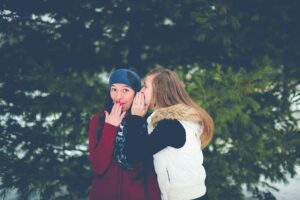By Prof Tony Attwood and Dr Michelle Garnett
The diagnostic criteria for autism include criterion A3, …difficulties in making friends…(APA 2022). We would add from our clinical experience that when friendships are made, an autistic child or adolescent may also have difficulty maintaining friendships. Non-autistic children can intuitively know how to initiate, sustain, and repair friendships. These abilities seem elusive for autistic children who often yearn for the quality of friendships of their peers. We have found that autistic children make very good friends, they typically have exceptional personality qualities, such as loyalty, honesty, compassion, integrity, a sense of social justice, open-mindedness and a good sense of humour. Their difficulty lies is in understanding and reading non autistic people, and in innately knowing how to conduct a friendship.
Common friendship difficulties for autistic children
As clinicians, we recognise that autistic children tend to have a concept of friendship that is developmentally younger than their non-autistic peers, usually by 2-4 years. The duration and frequency of their social engagement with peers is less, and their social and friendship network is therefore reduced. We have found that autistic children and adolescents have difficulty identifying and defining the components of friendship and understanding the multiple dimensions of friendship, which has now been confirmed by research (Petrina, Carter and Stephenson, 2014). Reading non-verbal communication and social context can also be difficult, as well as accommodating alternative perspectives and managing conflict in a friendship. There is also the issue of sensory sensitivity when socially engaged with noisy non-autistic peers and the perception of chaos when social games are complex and fast-moving. They may seek a safe sanctuary on the periphery of social activities where they can relax, but being alone may be a cue for non-autistic peers to see them as a target for teasing and bullying. We have also noted that when a friendship is made, it may be with another autistic student who shares the same interests and an autistic way of thinking and relating. However, they may meet after school less often than would be expected by non-autistic peers. Their friendship tends to be primarily school-based.
Gender differences in friendship abilities
Over the last decade, there has been research comparing the friendship abilities and experiences of autistic girls in comparison to autistic boys. Autistic girls tend to have significantly better social interaction and communication skills than autistic boys, and this characteristic may not be captured by current diagnostic instruments (Wood-Downie et al., 2021). The Friendship Questionnaire was designed to measure friendship skills in autistic children and adults (Baron-Cohen & Wheelwright, 2003). A study of 10-16-year-old children using this instrument found that autistic girls and non-autistic boys tended to have similar Friendship Quotient scores, and autistic girls had greater friendship quotient scores than autistic boys (Head, McGillvray and Stokes 2014). This may partially explain why autistic girls’ friendship abilities are perceived as comparable to typical boys and, therefore, not of clinical concern, and contributing to autistic girls choosing boys rather than girls as friends.
Friendships during the pre-school and primary school years
A study of autistic children in the preschool years found that only 20% had friendships at school and that while at school, adults rarely tried to intervene to encourage engagement with peers. The adults’ primary involvement was to correct behaviour (Chang Shih & Kasari, 2016). In the primary school years, autistic boys tend to be overtly excluded by peers, while autistic girls were more ignored or overlooked rather than actively rejected (Dean et al., 2014) Autistic children become less socially connected with increasing grade level, especially after grade 4 when social games and friendships become more sophisticated and for boys, greater sportsmanship required (Rotherham-Fuller et al., 2010). Our clinical experience is that when autistic children are asked to name their friends at primary school, the children named tend not to consider the autistic child as part of their friendship group. This may be due to an autistic child having difficulty differentiating between someone who is friendly, and a true friend as defined by their peers.
The degree of social engagement can vary considerably after grade 4 and partly depends on the child’s motivation for social inclusion or isolation (Calder, Hill and Pellicano, 2013). Non-autistic children, increasingly after grade 4, seek emotional connectedness in friendships, while autistic children see friendship as primarily someone to play with rather than someone who provides emotional support.
Programmes to encourage friendship abilities
Encouraging friendship abilities can equip the person to understand others and develop skills to navigate the social world with more success. The person can also learn how to be their own best friend, which is an important skill for a happier life.
There are several evidence-based programmes to encourage friendship abilities. Elizabeth Laugeson originally developed the PEERS programme for autistic adolescents and young adults (Laugeson et al., 2015). The programme includes components on developing and maintaining friendships, conversation skills, electronic communication, appropriate use of humour and romantic relationships and dating etiquette. A recent meta-analysis of research on the PEERS programme found moderate to large effects across measures and informants, with the largest effect in social knowledge, then social functioning and the smallest in the frequency of get-togethers. The PEERS programme has now been adapted for preschool autistic children (Tripathi et al., 2022). The programme themes include meeting and greeting friends, sharing and taking turns, asking a friend to play, joining a game, and asking for and giving help.
The Secret Agent Society is a home or school-based computer programme that includes activities to explain and enhance friendship abilities for 8-12 year old children (Beaumont et al. (2021) with more information at www.sst.institute.net
Parents and teachers recognise the popularity of Lego and Minecraft for autistic children. Daniel Le Goff has developed and evaluated Lego-based therapy to encourage social and friendship skills (LeGoff et al., 2017). Dundon and Scott (2019) have written a manual describing how Minecraft can be used to teach autistic children social skills. Jessica Kingsley Publishers (JKP) has published a range of books on Social Stories, originally developed by Carol Grey that can be used to encourage specific friendship abilities. JKP has also published several books by Jennifer Cook that explore and encourage social abilities for autistic children and adolescents. We also recommend the Social Thinking programmes developed by Michelle Garcia Williams and Pamela Crooke, with more information at www.socialthinking.com
Where to from here?
We have created two consecutive half-day presentations exploring autism and friendship. Both presentations describe friendship issues and how to help, with the morning focussing on children from 3-12 years old, and the afternoon focussing on adolescents. We designed the webcasts for parents, teachers and professionals, including psychologists and speech pathologists who wish to support autistic children and teenagers to build connections with their peers.
ONLINE COURSE: Exploring Friendship in the Primary Years
ONLINE COURSE: Exploring Friendship in High School
References
APA (2022) Diagnostic and Statistical Manual of Mental Disorders-5 Text Revision. American Psychiatric Association
Attwood, T. (2006) The Complete Guide to Asperger’s Syndrome. London, Jessica Kingsley Publishers.
Baron-Cohen and Wheelwright, (2003) Journal of Autism and Developmental Disorders 33, 509–517.
Beaumont et al. (2021). Journal of Autism and Developmental Disorders 51, 3637-3650
Calder, Hill and Pellicano (2013) Autism 17
Chang Shih and Kasari (2016). Autism 20
Cresswell, Hinch and Cage (2019) Research in ASD 61, 45-60
Daniel and Billingsley 2010 Focus on ASD and other Developmental Disorders 25
Dean et al. (2014) Journal of Child Psychology and Psychiatry 55, 1218-1225
Dundon and Scott (2019) Teaching Social Skills to Children with Autism using Minecraft London, Jessica Kingsley Publishers.
Foggo and Webster (2017). Research in ASD 35
Head, McGillvray and Stokes (2014) Molecular Autism
Hull et al. (2017) Journal of Autism and Developmental Disorders 47, 2519-2534
Laugeson et al. (2015) Journal of Autism and Developmental Disorders 45
LeGoff et al (2017) How Lego-based Therapy for Autism Works Jessica Kingsley Publishers
Petrina, Carter and Stephenson (2014) Research in Autism Spectrum Disorders 8, 111-126
Platos and Pisula (2021) Research in ASD 81 101716
Rotherham-Fuller et al. (2010) Journal of Child Psychology and Psychiatry 51, 1227-1234
Rothman et al (2022) Autism 26, 690-702
Sedgewick, Hill and Pellicano Autism (2018)
Tripathi et al. (2022) Jr Autism and Developmental Disorders 52, 2610-2626
Wood-Downie et al. (2021) Journal of Child Psychology and Psychiatry 62, 922-936




